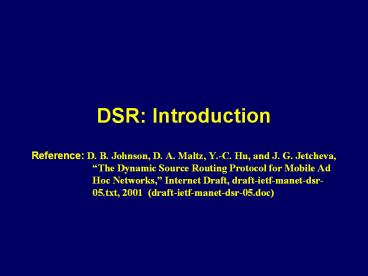DSR: Introduction - PowerPoint PPT Presentation
1 / 15
Title:
DSR: Introduction
Description:
DSR: Introduction Reference: D. B. Johnson, D. A. Maltz, Y.-C. Hu, and J. G. Jetcheva, The Dynamic Source Routing Protocol for Mobile Ad Hoc Networks, Internet ... – PowerPoint PPT presentation
Number of Views:145
Avg rating:3.0/5.0
Title: DSR: Introduction
1
DSR Introduction
- Reference D. B. Johnson, D. A. Maltz, Y.-C. Hu,
and J. G. Jetcheva, The Dynamic Source Routing
Protocol for Mobile Ad Hoc Networks, Internet
Draft, draft-ietf-manet-dsr-05.txt, 2001
(draft-ietf-manet-dsr-05.doc)
2
Introduction
- Basic idea
- Each data packet sent carries in its header the
complete, ordered list of nodes through which the
packet will pass, allowing packet routing to be
trivially loop-free and avoiding the need for
up-to-date routing information in the
intermediate nodes - Other nodes forwarding or overhearing any of
these packets may also easily cache this routing
information for future use
3
Introduction (cont)
- Two mechanisms
- Route discovery Route maintenance
- On demand protocol
- DSR requires no periodic packets of any kind at
any level within the network - For example, DSR does not use any periodic
routing advertisement, link status sensing, or
neighbor detection packets, and does not rely on
these functions from any underlying protocol in
the network
4
Assumption
- Small diameter of the network
- 5 10 hops
- Node speed
- Moderate with respect to the packet transmission
latency and wireless transmission range - Promiscuous receive mode
- Causes the hardware to deliver every received
packet to the network driver software without
filtering based on link-layer destination address
5
DSR Protocol
- Basic route discovery
- To initiate the Route Discovery
- The initiator transmits a Route Request as a
single local broadcast packet - Each Route Request identifies the initiator and
target of the Route Discovery, and also contains
a unique request identification - Each Route Request also contains a record listing
the address of each intermediate node through
which this particular copy of the Route Request
has been forwarded
6
DSR Protocol (cont)
- Neighbor node receiving the Route Request
- Discard the packet if
- 1. It has recently seen another Route Request
message from this initiator bearing this same
request ID and target address, or - 2. This nodes own address is already listed in
the route record in the Route Request - Otherwise, this node appends its own address to
the route record and propagates it by
transmitting it as a local broadcast packet
7
DSR Protocol (cont)
- Target of Route Request
- Returns a Route Reply (unicast) to the
initiator of the Route Discovery - When the initiator receives this Route Reply, it
caches this route in its Route Cache for using in
sending subsequent packets to this destination
8
DSR Protocol (cont)
- Basic Route Maintenance
- E.g. if node C is unable to deliver the packet to
the next hop D, then C returns a Route Error to
the original sender of the packet (node A)
9
DSR Protocol (cont)
- Node A then removes this broken link from its
cache any retransmission of the original packet
can be performed by upper layer protocols - For sending such a retransmission or other
packets to this same destination E - If A has in its Route Cache another route to E,
it can send the packet using the new route
immediately - Otherwise, node A should perform a new Route
Discovery for this target
10
DSR Protocol (cont)
- Additional Route Discovery Features
- 1. Caching Overheard Routing Information
- A node forwarding or otherwise overhearing any
packet may add the routing information from that
packet to its own Route Cache - 2. Replying the Route Requests using Cached
Routes - A node (not target) receiving a Route Request
searches its own Route Cache for a route to the
target. If found, the node generally returns a
Route Reply to the initiator itself rather than
forwarding the Route Request
11
DSR Protocol (cont)
- 3. Preventing Route Reply Storms
- Each node delays sending its own Route Reply for
a short period (it randomizes the time at which
each node sends its Route Reply)
12
DSR Protocol (cont)
- 4. Route Request Hop Limits
- Using the Time-to-Live (TTL) field in the IP
header - For controlling the spread of a Route Request
during a Route Discovery attempt - Expanding ring search
13
DSR Protocol (cont)
- Additional Route Maintenance Features
- 1. Packet Salvaging
- After sending a Route Error message for a failed
link, a node may attempt to salvage the data
packet that cause the Route Error rather than
discarding the packet - If a route is found for the destination of the
packet, the node replaces the original source
route on the packet with the route from its Route
Cache and forwards the packet
14
DSR Protocol (cont)
- 2. Automatic Route Shortening
- Source routes in use may be automatically
shortened if one or more intermediate hops in the
route become no longer necessary ? Gratuitous
Route Reply - E.g. node D overheard a data packet being
transmitted from B to C, for later forwarding to
D and to E. - Node D returns a gratuitous Route Reply to the
original sender of the packet (node A) - The Route Reply gives the shorter route
15
DSR Protocol (cont)
- 3. Increased Spreading of Route Error Messages
- When a source node receives a Route Error for a
data packet that it originated - This source node propagates this Route Error to
its neighbors by piggybacking it on its next
Route Request - In this way, stale information in the caches of
nodes around this source node will not generate
Route Replies that contain the same invalid link































